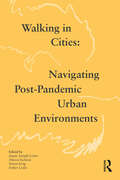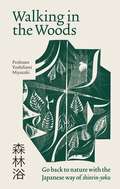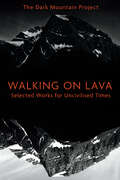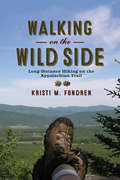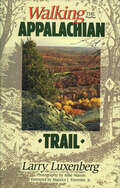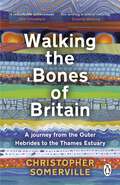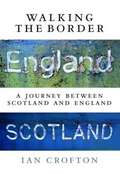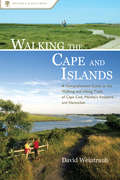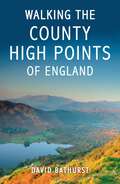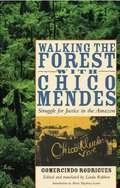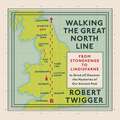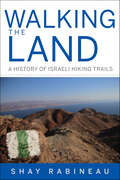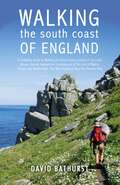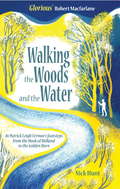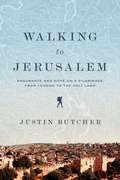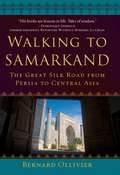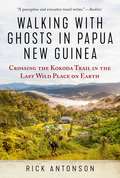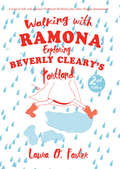- Table View
- List View
Walking in Cities: Navigating Post-Pandemic Urban Environments
by Simon King Esther Leslie Ahuvia Kahane Jaspar Joseph-LesterThis book brings together an international group of artists and writers to respond to the question of how our new world orders force us to reconsider urban walking and urban spaces in ways which extend into the digital sphere of online dialogue and screen sharing. In their reflections on walking cities in lockdown, the artists and writers contributing to this book share a number of complementary themes. Key to this is the question of how we walk in post-pandemic cities and how such walking might motivate or be motivated by transgressive, atomised or collective thoughts, affects, relations and experiences. Here we see how navigating cities in lockdown requires us to re-territorialise, improvise, create and de- or re-politize. There is, for example, a clear distinction between the severe lockdown measures that were introduced in Cape Town and the liberal appeal to good citizenship that northern hemisphere cities such as Stockholm chose to rely on. These measures impact on the way we experience urban walking and, in each case, lead to deeper reflections about the heightened presence of ideological structures embedded within the urban.
Walking in the Woods: Go back to nature with the Japanese way of shinrin-yoku
by Yoshifumi Miyazaki'It is clear that our bodies still recognize nature as our home...' - Yoshifumi Miyazaki'Forest bathing' or shinrin-yoku is a way of walking in the woods that was developed in Japan in the 1980s. It brings together ancient ways and wisdom with cutting edge environmental health science. Simply put, forest bathing is the practice of walking slowly through the woods, in no hurry, for a morning, an afternoon or a day. It is a practice that involves all the senses and as you gently walk and breathe deeply, the essential oils of the trees are absorbed by your body and have an extraordinary effect on positive feelings, stress hormone levels, parasympathetic nervous activity, sympathetic nervous activity, blood pressure, heart rate and brain activity.In this wonderful book, by the leading expert in the field, science meets nature, as we are encouraged to bathe in the trees and become observers of both the environment around us and the goings on of our own minds.
Walking in the Woods: Go back to nature with the Japanese way of shinrin-yoku
by Yoshifumi Miyazaki'It is clear that our bodies still recognize nature as our home...' - Yoshifumi Miyazaki'Forest bathing' or shinrin-yoku is a way of walking in the woods that was developed in Japan in the 1980s. It brings together ancient ways and wisdom with cutting edge environmental health science. Simply put, forest bathing is the practice of walking slowly through the woods, in no hurry, for a morning, an afternoon or a day. It is a practice that involves all the senses and as you gently walk and breathe deeply, the essential oils of the trees are absorbed by your body and have an extraordinary effect on positive feelings, stress hormone levels, parasympathetic nervous activity, sympathetic nervous activity, blood pressure, heart rate and brain activity.In this wonderful book, by the leading expert in the field, science meets nature, as we are encouraged to bathe in the trees and become observers of both the environment around us and the goings on of our own minds.
Walking on Lava: Selected Works for Uncivilised Times
by The Dark Mountain ProjectThe Dark Mountain Project began with a manifesto published in 2009 by two English writers—Dougald Hine and Paul Kingsnorth—who felt that literature was not responding honestly to the crises of our time.In a world in which the climate is being altered by human activities; in which global ecosystems are being destroyed by the advance of industrial civilisation; and in which the dominant economic and cultural assumptions of the West are visibly crumbling, Dark Mountain asked: where are the writers and the artists? Why are the mainstream cultural forms of our society still behaving as if this were the twentieth century—or even the nineteenth?Dark Mountain&’s call for writers, thinkers and artists willing to face the depth of the mess we are in has made it a gathering point for a growing international network. Rooted in place, time and nature, their work finds a home in the pages of the Dark Mountain books, with two new volumes published every year.Walking on Lava brings together the best of the first ten volumes, along with the original manifesto. This collection of essays, fiction, poetry, interviews and artwork introduces The Dark Mountain Project&’s groundbreaking work to a wider audience in search of &‘the hope beyond hope, the paths which lead to the unknown world ahead of us.&’
Walking on the Wild Side: Long-Distance Hiking on the Appalachian Trail
by Kristi M. FondrenThe most famous long-distance hiking trail in North America, the 2,181-mile Appalachian Trail--the longest hiking-only footpath in the world--runs along the Appalachian mountain range from Georgia to Maine. Every year about 2,000 individuals attempt to "thru-hike" the entire trail, a feat equivalent to hiking Mount Everest sixteen times. In Walking on the Wild Side, sociologist Kristi M. Fondren traces the stories of forty-six men and women who, for their own personal reasons, set out to conquer America's most well known, and arguably most social, long-distance hiking trail. In this fascinating in-depth study, Fondren shows how, once out on the trail, this unique subculture of hikers lives mostly in isolation, with their own way of acting, talking, and thinking; their own vocabulary; their own activities and interests; and their own conception of what is significant in life. They tend to be self-disciplined, have an unwavering trust in complete strangers, embrace a life of poverty, and reject modern-day institutions. The volume illuminates the intense social intimacy and bonding that forms among long-distance hikers as they collectively construct a long-distance hiker identity. Fondren describes how long-distance hikers develop a trail persona, underscoring how important a sense of place can be to our identity, and to our sense of who we are. Indeed, the author adds a new dimension to our understanding of the nature of identity in general. Anyone who has hiked--or has ever dreamed of hiking--the Appalachian Trail will find this volume fascinating. Walking on the Wild Side captures a community for whom the trail is a sacred place, a place to which they have become attached, socially, emotionally, and spiritually.
Walking the Appalachian Trail
by Larry LuxenbergA fascinating portrait of the community of people—and one cat—who&’ve traveled the trail end to end, by the founder of the Appalachian Trail Museum. Countless hikers have walked stretches of the two-thousand-plus-mile Appalachian Trail, but only a small, deeply dedicated group has completed the trek all the way through from Georgia to Maine. This book explores the history of the trail through colorful profiles of those who are a part of this unique community and reveals the customs and culture that have evolved around them over the years. From the sore muscles to the moments of solitude in nature, from the retired postmaster who parachuted onto the top of Springer Mountain to begin his journey to the woman who set out in tennis shoes because she couldn&’t find women&’s hiking boots in her size, Walking the Appalachian Trail explores questions of who these end-to-enders are, what drives them, what risks they face, and what rewards to body and soul they gain from this extraordinary walk. Includes color photographs
Walking the Bones of Britain: A 3 Billion Year Journey from the Outer Hebrides to the Thames Estuary
by Christopher Somerville‘Somerville’s infectious enthusiasm and wry humour infuse his journey from the Isle of Lewis to southern England, revealing our rich geological history with vibrant local and natural history’ Observer‘A meticulous exploration of the ground beneath our feet. Glorious’ Katharine Norbury‘A remarkable achievement’ Tom Chesshyre‘His writing is utterly enticing’ Country Walking...............................................................................................................................................The influence Britain’s geology has had on our daily lives is profound. While we may be unaware of it, every aspect of our history has been affected by events that happened ten thousand, a million, or a thousand million years ago.In Walking the Bones of Britain, Christopher Somerville takes a journey of a thousand miles, beginning in the far north, at the three-billion-year-old rocks of the Isle of Lewis, formed when the world was still molten, and travelling south-eastwards to the furthest corner of Essex, where new land is being formed. Crossing bogs, scaling peaks and skirting quarry pits, he unearths the stories bound up in the layers of rock beneath our feet, and examines how they have influenced everything from how we farm to how we build our houses, from the Industrial Revolution to the current climate crisis.Told with characteristic humour and insight, this gripping exploration of the British landscape and its remarkable history cannot fail to change the way you see the world beyond your door.‘Somerville is a walker’s writer’ Nicholas Crane
Walking the Border: A Journey Between Scotland and England
by Ian CroftonThis travelogue about one man&’s journey by foot along the border between Scotland and England blends nature, history, and politics. In this book, Ian Crofton travels on foot from Gretna Green in the southwest to Berwick in the northeast, following as close as possible the Anglo-Scottish Border as it has been fixed since the union of the crowns in 1603. Much of the line of the Border runs through a wild, overwhelmingly unvisited no man&’s land—the sort of trackless waste perfect for keeping two belligerent peoples apart? During the course of his journey, Crofton considers a number of questions like how &“natural&” are borderlines? Sometimes they follow physical barriers, sometimes an arbitrary line on a map, the compromise made by some committee of distant diplomats…Praise for Walking the Border&“There is a lot of excellent natural description in this book, alongside a number of comic encounters with humans and livestock.&” —The Guardian (UK)
Walking the Cape and Islands
by David WeintraubThe Cape and Islands-Cape Cod, Martha's Vineyard, and Nantucket-provide some of the best walking and hiking in coastal New England. There is a great variety of terrain and scenery, from the crashing Atlantic Ocean to pristine kettle ponds, from densely wooded tracts to open expanses of salt marsh, and from sandy shorelines to wildflower-carpeted grasslands. Walking the Cape and Islands is the first comprehensive guide to the area's best walking and hiking trails. In includes: 72 walks ranging in length from 0.4 miles to 11.2 miles and in difficulty from easy to difficult; for each walk, a complete route description, driving directions to the trailhead, and a detailed, easy-to-read map; at-a-glance Info providing essential information such as distance, difficulty, time to walk, trail surface, and more; trail-use data showing whether bicycles, dogs, or hunting are allowed on the described route; and health stats showing the number of steps and estimated calories burned. Although designed primarily for walkers and hikers, this book will also appeal to joggers and mountain bicyclists. The book is illustrated with photographs by the author, a professional photographer.
Walking the County High Points of England
by David BathurstAn indefatigable walker, David Bathurst has unlaced his boots to produce this unique companion to the country’s most rewarding hilltop trails, from the Pennine Way to the misty Malverns. His appreciation of the beauty and history of the British countryside and his light-hearted style will appeal to experienced and novice walkers alike.
Walking the County High Points of England
by David BathurstAn indefatigable walker, David Bathurst has unlaced his boots to produce this unique companion to the country’s most rewarding hilltop trails, from the Pennine Way to the misty Malverns. His appreciation of the beauty and history of the British countryside and his light-hearted style will appeal to experienced and novice walkers alike.
Walking the Dead Diamond River: Nineteen Essays
by Edward Coolbaugh HoaglandThe nineteen essays in this important collection explore the New England wilderness including the Green and White Mountains and Maine - and also such a far-flung diversity of subjects as assassinations, dogs, jury duty, mountain lions, power, fame, women's liberation, life in New York City, boxing, freight cars, and much more.
Walking the Forest with Chico Mendes: Struggle for Justice in the Amazon
by Gomercindo RodriguesA close associate of Chico Mendes, Gomercindo Rodrigues witnessed the struggle between Brazil's rubber tappers and local ranchers--a struggle that led to the murder of Mendes. Rodrigues's memoir of his years with Mendes has never before been translated into English from the Portuguese. Now, Walking the Forest with Chico Mendes makes this important work available to new audiences, capturing the events and trends that shaped the lives of both men and the fragile system of public security and justice within which they lived and worked. In a rare primary account of the celebrated labor organizer, Rodrigues chronicles Mendes's innovative proposals as the Amazon faced wholesale deforestation. As a labor unionist and an environmentalist, Mendes believed that rain forests could be preserved without ruining the lives of workers, and that destroying forests to make way for cattle pastures threatened humanity in the long run. Walking the Forest with Chico Mendes also brings to light the unexplained and uninvestigated events surrounding Mendes's murder. Although many historians have written about the plantation systems of nineteenth-century Brazil, few eyewitnesses have captured the rich rural history of the twentieth century with such an intricate knowledge of history and folklore as Rodrigues.
Walking the Great North Line: From Stonehenge to Lindisfarne to Discover the Mysteries of Our Ancient Past
by Robert TwiggerRobert Twigger, poet and travel author, was in search of a new way up England when he stumbled across the Great North Line. From Christchurch on the South Coast to Old Sarum to Stonehenge, to Avebury, to Notgrove barrow, to Meon Hill in the midlands, to Thor's Cave, to Arbor Low stone circle, to Mam Tor, to Ilkley in Yorkshire and its three stone circles and the Swastika Stone, to several forts and camps in Northumberland to Lindisfarne (plus about thirty more sites en route). A single dead straight line following 1 degree 50 West up Britain. No other north-south straight line goes through so many ancient sites of such significance. Was it just a suggestive coincidence or were they built intentionally? Twigger walks the line, which takes him through Birmingham, Halifax and Consett as well as Salisbury Plain, the Peak district, and the Yorkshire moors. With a planning schedule that focused more on reading about shamanism and beat poetry than hardening his feet up, he sets off ever hopeful. He wild-camps along the way, living like a homeless bum, with a heart that starts stifled but ends up soaring with the beauty of life. He sleeps in a prehistoric cave, falls into a river, crosses a 'suicide viaduct' and gets told off by a farmer's wife for trespassing; but in this simple life he finds woven gold. He walks with others and he walks alone, ever alert to the incongruities of the edgelands he is journeying through.
Walking the Great North Line: From Stonehenge to Lindisfarne to Discover the Mysteries of Our Ancient Past
by Robert TwiggerRobert Twigger, poet and travel author, was in search of a new way up England when he stumbled across the Great North Line. From Christchurch on the South Coast to Old Sarum to Stonehenge, to Avebury, to Notgrove barrow, to Meon Hill in the midlands, to Thor's Cave, to Arbor Low stone circle, to Mam Tor, to Ilkley in Yorkshire and its three stone circles and the Swastika Stone, to several forts and camps in Northumberland to Lindisfarne (plus about thirty more sites en route). A single dead straight line following 1 degree 50 West up Britain. No other north-south straight line goes through so many ancient sites of such significance. Was it just a suggestive coincidence or were they built intentionally? Twigger walks the line, which takes him through Birmingham, Halifax and Consett as well as Salisbury Plain, the Peak district, and the Yorkshire moors. With a planning schedule that focused more on reading about shamanism and beat poetry than hardening his feet up, he sets off ever hopeful. He wild-camps along the way, living like a homeless bum, with a heart that starts stifled but ends up soaring with the beauty of life. He sleeps in a prehistoric cave, falls into a river, crosses a 'suicide viaduct' and gets told off by a farmer's wife for trespassing; but in this simple life he finds woven gold. He walks with others and he walks alone, ever alert to the incongruities of the edgelands he is journeying through.
Walking the Great North Line: From Stonehenge to Lindisfarne to Discover the Mysteries of Our Ancient Past
by Robert TwiggerRobert Twigger, poet and travel author, was in search of a new way up England when he stumbled across the Great North Line. From Christchurch on the South Coast to Old Sarum to Stonehenge, to Avebury, to Notgrove barrow, to Meon Hill in the midlands, to Thor's Cave, to Arbor Low stone circle, to Mam Tor, to Ilkley in Yorkshire and its three stone circles and the Swastika Stone, to several forts and camps in Northumberland to Lindisfarne (plus about thirty more sites en route). A single dead straight line following 1 degree 50 West up Britain. No other north-south straight line goes through so many ancient sites of such significance. Was it just a suggestive coincidence or were they built intentionally? Twigger walks the line, which takes him through Birmingham, Halifax and Consett as well as Salisbury Plain, the Peak district, and the Yorkshire moors. With a planning schedule that focused more on reading about shamanism and beat poetry than hardening his feet up, he sets off ever hopeful. He wild-camps along the way, living like a homeless bum, with a heart that starts stifled but ends up soaring with the beauty of life. He sleeps in a prehistoric cave, falls into a river, crosses a 'suicide viaduct' and gets told off by a farmer's wife for trespassing; but in this simple life he finds woven gold. He walks with others and he walks alone, ever alert to the incongruities of the edgelands he is journeying through.
Walking the Land: A History of Israeli Hiking Trails (Perspectives on Israel Studies)
by Shay RabineauIsrael has one of the most extensive and highly developed hiking trail systems of any country in the world. Millions of hikers use the trails every year during holiday breaks, on mandatory school trips, and for recreational hikes. Walking the Land offers the first scholarly exploration of this unique trail system. Featuring more than ten thousand kilometers of trails, marked with hundreds of thousands of colored blazes, the trail system crisscrosses Israeli-controlled territory, from the country's farthest borders to its densest metropolitan areas. The thousand-kilometer Israel National Trail crosses the country from north to south. Hiking, trails, and the ubiquitous three-striped trail blazes appear everywhere in Israeli popular culture; they are the subjects of news articles, radio programs, television shows, best-selling novels, government debates, and even national security speeches. Yet the trail system is almost completely unknown to the millions of foreign tourists who visit every year and has been largely unstudied by scholars of Israel. Walking the Land explores the many ways that Israel's hiking trails are significant to its history, national identity, and conservation efforts.
Walking the South Coast of England: A Complete Guide to Walking the South-facing Coasts of Cornwall, Devon, Dorset, Hampshire (including the Isle of Wight), Sussex and Kent, from Lands End to the South Foreland
by David BathurstFor this detailed guide to some of the best walking in Britain, David Bathurst has walked over 700 miles of coast, taking in breathtaking natural landscapes and significant landmarks on the way. Whether you’re a seasoned hiker or a summertime stroller, this guidebook is a must-have for walking on England’s south coast.
Walking the South Coast of England: A Complete Guide to Walking the South-facing Coasts of Cornwall, Devon, Dorset, Hampshire (including the Isle of Wight), Sussex and Kent, from Lands End to the South Foreland
by David BathurstFor this detailed guide to some of the best walking in Britain, David Bathurst has walked over 700 miles of coast, taking in breathtaking natural landscapes and significant landmarks on the way. Whether you’re a seasoned hiker or a summertime stroller, this guidebook is a must-have for walking on England’s south coast.
Walking the Woods and the Water
by Nick Hunt"Nick Hunt has written a glorious book, rich with insight and wit, about walking his way both across and into contemporary Europe. . . . So many memorable encounters with people and places! A book about gifts, modernity, endurance and landscape, it represents a fine addition to the literature of the leg."--Robert Macfarlane, award-winning travel writer, author of The Wild Places and The Old Ways: A Journey On Foot"This moving and profoundly honest book sometimes brings a sense of unlimited freedom, sometimes joy, sometimes an extraordinary, dream-like dislocation: always accompanied by a dazzling sharpness of hearing and vision. I see now how that youthful walk informed so much of Paddy's style. Before setting out Hunt was going to write to Paddy. The letter was never written, and by the time he set off, Paddy was dead. How touched and fascinated he would have been to read this book."--Artemis Cooper, biographer of Patrick Leigh Fermor and co-editor of The Broken RoadIn 1933, eighteen-year-old Patrick Leigh Fermor set out to chance and charm his way across Europe, "like a tramp, a pilgrim, or a wandering scholar." The books he later wrote about this walk, including Between the Woods and the Water, are a half-remembered, half-reimagined journey through cultures now extinct and landscapes irrevocably altered by the traumas of the twentieth century.Nick Hunt dreamed of following in Fermor's footsteps. Eighty years later he began his own "great trudge"--on foot all the way to Istanbul. He walked across eight countries, following two major rivers and crossing three mountain ranges. With only Fermor's books to guide him, he trekked some 2,500 miles from Holland to Turkey.Why? For an old-fashioned adventure. To discover for himself what remained of hospitality, kindness to strangers, freedom, wildness, the unknown, the deeper currents of myth that still flow beneath Europe's surface. This is a story worthy of Fermor's own.Nick Hunt is a travel writer, freelance journalist, fiction writer, and storyteller whose articles have appeared in the Economist, the Guardian, and other publications. He is also co-editor of The Dark Mountain.
Walking the Woods and the Water: In Patrick Leigh Fermor's Footsteps from the Hook of Holland to the Golden Horn
by Nick HuntIn 1933, the eighteen year old Patrick Leigh Fermor set out in a pair of hobnailed boots to chance and charm his way across Europe, like a tramp, a pilgrim or a wandering scholar. The books he later wrote about this walk, A Time of Gifts, Between the Woods and the Water, and the posthumous The Broken Road are a half-remembered, half-reimagined journey through cultures now extinct, landscapes irrevocably altered by the traumas of the twentieth century. Aged eighteen, Nick Hunt read A Time of Gifts and dreamed of following in Fermor's footsteps.In 2011 he began his own great trudge - on foot all the way to Istanbul. He walked across Europe through eight countries, following two major rivers and crossing three mountain ranges. Using Fermor's books as his only travel guide, he trekked some 2,500 miles through Holland, Germany, Austria, Slovakia, Hungary, Romania, Bulgaria and Turkey. His aim? To have an old-fashioned adventure. To slow down and linger in a world where we pass by so much, so fast. To discover for himself what remained of hospitality, kindness to strangers, freedom, wildness, adventure, the mysterious, the unknown, the deeper currents of myth and story that still flow beneath Europe's surface.
Walking to Jerusalem: Endurance And Hope On A Pilgrimage From London To The Holy Land
by Justin ButcherA moving and informative narrative of a six-month walk from London to Jerusalem on the centenary of the Balfour Declarations. On the centenary of the Balfour Declaration, which was also the fiftieth anniversary of the since the Six-day War and the tenth anniversary of the Blockade of Gaza, Justin Butcher—along with ten other companions (and another hundred joining him at points along the way)—walked from London to Jerusalem as an act of solidarity, penance, and hope. Weaving in history of the Holy Land as he moves across Europe, from Balfour and Christian Zionism, to colonialism and Jerusalem Syndrome, from desert spirituality to the lives of his fellow travelers, Walking to Jerusalem is a chronicle of serendipity, the hilarious, the infuriating, and, occasionally, an encounter with the Divine.
Walking to Samarkand: The Great Silk Road from Persia to Central Asia
by Bernard OllivierAcclaimed journalist Bernard Ollivier continues his epic journey across Persia and Central Asia as he walks the length of the Great Silk Road. Walking to Samarkand is journalist Bernard Ollivier&’s stunning account of the second leg of his 7,200-mile walk from Istanbul, Turkey, to Xi&’an, China, along the Silk Road--the longest and perhaps most mythical trade route of all time. Picking up where Out of Istanbul left off, Ollivier heads out of the Middle East and into Central Asia, grappling not only with his own will to continue but with new, unforeseen dangers. After crossing the final mountain passes of Turkish Kurdistan, Ollivier sets foot in Iran, keen on locating vestiges of the silk trade as he passes through Persia&’s modern cities and traditional villages, including Tabriz, Tehran, Nishapur, and the holy city of Mashhad. Beyond urban areas lie deserts: first Iran&’s Great Salt Desert, then Turkmenistan&’s forbidding Karakum, whose relentless sun, snakes, and scorpions pose continuous challenges to Ollivier&’s goal of reaching Uzbekistan. Setting his own fears aside, he travels on, wonderstruck at every turn, borne by a childhood dream: to see for himself the golden domes and turquoise skies of Samarkand, one of Central Asia&’s most ancient cities. But what Ollivier enjoys most are the people along the way: Askar, the hospitable gardener; the pilgrims of Mashhad; and his knights in shining armor, Mehdi and Monir. For, despite setting out alone, he comes to find that walking itself—through a kind of alchemy—surrounds him with friends and fosters fellowship. From the authoritarian mullahs of revolutionary Iran to the warm welcome of everyday Iranians—custodians of age-old, cordial Persian culture; from the stark realities of former Soviet republics to the region&’s legendary bazaars—veritable feasts for the senses—readers discover, through the eyes of a veteran journalist, the rich history and contemporary culture of these amazing lands.
Walking with Ghosts in Papua New Guinea: Crossing the Kokoda Trail in the Last Wild Place on Earth
by Rick AntonsonAcclaimed travel writer Rick Antonson (Full Moon Over Noah’s Ark) tackles his most challenging adventure yet: a formidable trail through the remote jungles of Papua New Guinea. Rick Antonson has traveled to parts of the world that are not simply exotic but sometimes damned near inaccessible. He has climbed to the summit of Mount Ararat in eastern Turkey, traveling beyond to Iraq and Iran and Armenia. He has undertaken an improbable overland journey to the ancient city of Timbuktu, an enlightening look into efforts to preserve the city’s priceless manuscripts. Now he has traversed the notorious Kokoda Trail in Papua New Guinea, a country some call “the last wild place on earth.” The trail is a narrow, 60-mile footpath featuring rough jungle, 6,000 feet in elevation change, and punishing weather extremes. In a country unfairly locked in Western misperceptions, the track is inhospitable terrain yet home to hospitable indigenous peoples, who live among the rusting reminders of the Japanese, Australian, and American armies that clashed in some of the deadliest protracted combat of World War II. In Walking With Ghosts in Papua New Guinea, Antonson shares a journey of physical and mental endurance in his inimitable way, in the company of a mixed band of resolute adventurers, blending fascinating historical context with the tribulations of unexpected discoveries in faraway lands.
Walking with Ramona: Exploring Beverly Cleary's Portland (People's Guide Ser.)
by Laura O. FosterThis unique travel guide explores the streets, schools, characters, and neighborhoods of author Beverly Cleary’s Portland. With this new and most unusual guidebook, readers can walk the very sidewalks that Beverly walked and climb the very school steps that Beverly climbed. You'll see the grocery parking lot where Ramona got stuck in the mud, the park lawn where Henry Huggins hunted nightcrawlers, and the real Portland street that became Klickitat Street, their fictional home. Beverly Cleary’s Portland was much different than the Portlandia of today. Walking with Ramona brings to life what 1920s and 1930s Portland was like for the “girl from Yamhill” who went on to become an internationally beloved author. Characters like Ramona and Beezus, Henry and Ribsy, and Ellen and Austine come to life on this hour-long walking route through the Northeast Portland neighborhood where Beverly grew up.
